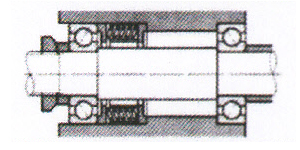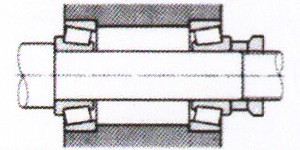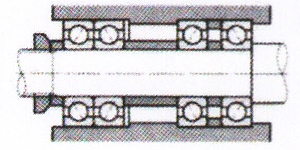BEARING PRELOAD
When the bearing is in use, it usually has an appropriate working clearance. However, in order to reduce the vibration of the micro motor bearing, sometimes the axial load is applied to the bearing in advance to make it have a negative internal clearance. This practice is called preloading.
The purpose of preloading
> Improve radial or axial positioning accuracy, while reducing bearing runout and improving rotation accuracy.
> Prevent abnormal bearing noise caused by vibration and resonance.
Preload method
There are two methods of applying pretension: positioning pretension and constant pressure pretension. The specific methods and characteristics are as follows:
Positioning preload

Deep groove ball bearing
Features of positioning preload: a structure that uses elastic parts such as spiral springs and wave washers to give warnings to bearings.
Advantages: it is less affected by temperature changes.
Disadvantage: It is the characteristics of increasing the amount of structural parts and reducing the rigidity.
Constant pressure preload

Tapered bearing
Features of constant pressure preload: a method to obtain preload through the relationship of mechanical position.
Advantages: simple structural parts and high rigidity.
Disadvantages: the preload has a large amount of change due to temperature changes, and the preload fades due to wear.
For micro motor bearings, the wave washer constant pressure pre-tightening method is generally used.
Constant pressure preload

Deep groove ball bearing
Features of constant pressure preload: a method to obtain preload through the relationship of mechanical position.
Advantages: simple structural parts and high rigidity.
Disadvantages: the preload has a large amount of change due to temperature changes, and the preload fades due to wear.
For micro motor bearings, the wave washer constant pressure pre-tightening method is generally used.
Comparison of positioning preload and constant pressure preload
1. When the pre-tightening force basin is equal, the positioning pre-tightening force is effective to increase the rigidity of the bearing, that is, the positioning pre-tightening force has the smallest displacement to the bearing load.
2. Positioning preload. During operation, the axial extension difference caused by the temperature difference between the shaft and the housing, the radial thermal expansion difference caused by the temperature difference between the inner ring and the outer ring, and the deformation caused by the load, make The preload load changes monthly.
In the case of constant pressure preload, the spring load (spring load) caused by the expansion and contraction of the shaft is small, so there is no need to consider the change of the preload.
It can be seen from this that the general positioning preload is suitable for the purpose of improving rigidity, and the constant pressure preload is suitable for high-speed rotation. To prevent axial vibration, the horizontal shaft uses a thrust bearing.
Preload
The preload is not arbitrarily decided, it should be decided according to the bearing size. If the preload is too large, the service life will be shortened and the friction torque will also change. If the pre-tightening force is too small, it will increase the vibration, the rigidity will be poor, and cause the slight vibration of the raceway surface
Wear. Therefore, when using bearings, it is very important to set the preload force correctly.
Light warning
Early warning power: 1.0%℃
Features: Regardless of shaft rigidity, emphasis on low friction torque
Medium warning
Early warning power: 1.5%℃
Features: Need to consider shaft rigidity and low friction torque
High warning
Early warning power: 2.0%℃
Features: Pay attention to shaft rigidity, low friction torque can be slightly higher
Rough selection criteria for preload
In occasions requiring low starting torque, light preload is usually selected; in occasions with rigidity requirements, medium preload is usually used first. When used in high-speed rotation occasions, heavy preload or with a famous ball bearing engineer is generally selected. Contact, more careful selection of preload.

